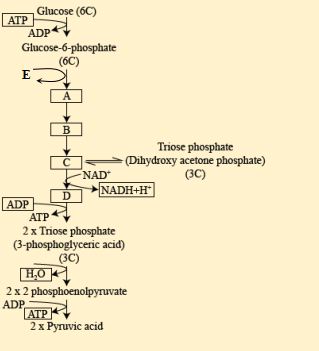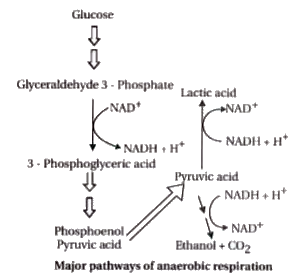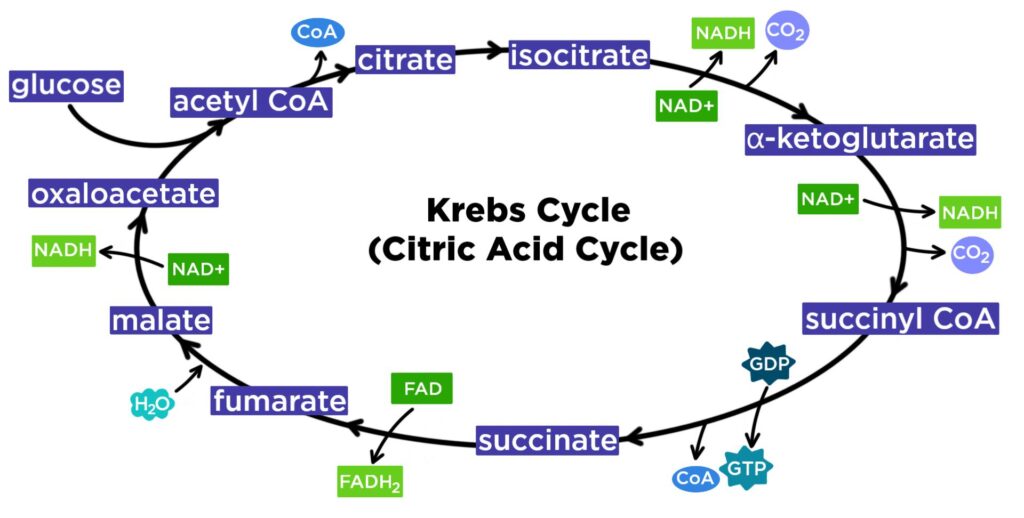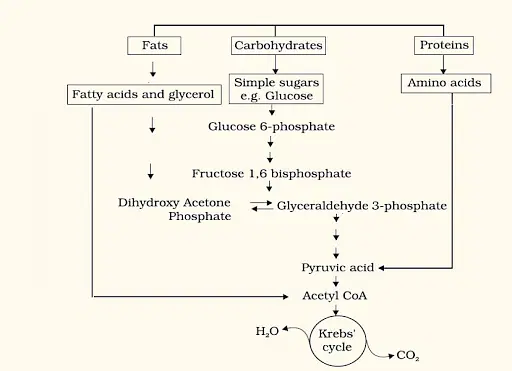RESPIRATION IN PLANTS- INTRODUCTION
- Respiration in plants, all living organisms need energy for carrying out daily life activities, like absorption, transport, movement, reproduction or even breathing.
- All the energy required for ‘life’ processes is obtained by oxidation of macromolecules, called food.
- Cellular respiration is the mechanism of breakdown of food material within the cell to release energy, and trapping it for synthesis of ATP. The process takes place in the cytoplasm and in the mitochondria.
- The compounds that are oxidised during this process are called the respiratory substrates like carbohydrates, protein, fats and even organic acids.
- The process involves a series of slow step-wise reactions controlled by enzymes and the released energy is trapped as chemical energy in the form ATP, which is broken down whenever energy needs to be utilised.
DO PLANTS BREATHS?
- Respiration in Plants have systems in place to ensure O2 availability, i.e stomata and lenticels for this purpose.
- Each plant part takes care of its own gasexchange needs. There is very little transport of gases from one plant part to another.
- Roots, stems and leaves respire at rates far lower than animals do.
- Most of cells of a plant have at least a part of their surface in contact with air..
- Complete combustion of glucose produces CO2 and H2O as end products and yields energy most of which is given as heat.
- C6H12O6+6O→ 6CO2+6H2O+Energy
- But plants oxidise glucose in several small steps and enegy released is coupled to ATP synthesis.
- Facultative and obligate anaerobes, can respire in absence of O2.
- All organisms retain this stategy of partial glucose oxidation in absence of oxygen called GLYCOLYSIS.
RESPIRATION IN PLANTS-GLYCOLYSIS
- Greek-glycos= sugar and lysis=splitting.
- Scheme given by Embden,Meyerhof and Parnas, referred as EMP pathway.
- In anaerobic organisms, it is the only process in respiration.
- Occurs in CYTOPLASM and present in all living organisms.
- In this process glucose undergoes partial oxidation to form two molecules of pyruvic acid.
- In plats, glucose comes from sucrose (the end product of photosynthesis) or from stirage carbohydrates.
- Sucrose is converted into glucose and fructose by invertase and these monosaccharides enter the glycolytic pathway readily.
- In glycolysis, a chain of ten reactions produces pyruvate from glucose by the help of different enzymes.
- In glycolysis 2 ATP are utilised and total 4 ATP, 2 NADH+H+ and 2 molecules of pyruvic acid are produced.
- Pyruvic acid is the key product of glycolysis and metabolic fate depends on cellular need.
Three major fates:- 1. Lactic acid fermentation- Under anaerobic conditions
2. Alcoholic fermentation- Under anaerobic conditions
3. Krebs’ cycle- Aerobic,needs O2 supply

RESPIRATION IN PLANTS-FERMENTATION
- In fermentation, by yeast, incomplete oxidation of glucose is achieved under anaerobic conditions to produce CO2 and ethanol, by the help of enzymes pyruvate decarboxylase and alcohol dehydrogenase.
- Bacteria and in animal cells (muscles during exercise,when oxygen is inadequate for cellular respiration) pyruvate is reduced to lactic acid by lactate dehydrogenase.
- Less than 7% of the energy in glucose is released.
- Also the processes are hazardous as acid or alcohol is produced
- Yeast poison themselves to death when concentration of alcohol reaches about 13%.

TRICARBOXYLIC ACID CYCLE
(In mitochondrial matrix)
- Acetyl CoA produced by oxidative decarboxylation of pyruvic acid enters the TCA cycle more commonly known as kreb’s cycle condensation, then isomerisation.
- OAA →Acetyl CoA→Citric Acid→Isomerises→ Isocitrate
- Citrate synthase
- Followed by two successive decarboxylation to form α-ketoglutarate and the succinyl CoA.
- During conversion of succinyl CoA to succinic acid, substrate lvel phosphorylation takes place to produce GTP which in acoupled reaction simultaneously produces ATP.
- The summary equation for this phase of respiration is:-Pyruvate+4NAD+FAD+2H2O+ADP+Pi→MITOCHONDRIAL MATRIX→3CO2+4NADH+4H+FADH2+ATP
- So, per molecule of glucose, 8NADH+H+, two FADH2 and @ATP are synthesised from pyruvic acid.

AEROBIC RESPIRATION
- In eukaryotes, it takes place in mitochondria . Leads tocomplete oxidation of organic substances, in the presence of oxygen and release of CO2, water and a large amount of energy present in the substrate.
- This type of respiration is most common in higher organisms.
- For aerobic respiration to take place within mitochondria, thefinal product of glycolysis is transported into mitochondria from cytoplasm.
- Crucial events of aerobic respiration are:-
(a) Complete oxidation of pyruvic acid -site=Mitochondrial matrix.
(b) ETS and synthesis of ATP-site = inner mitochondrial membrane.
AMPHIBOLIC PATHWAY
- Respiration pathway is involved in both anabolism and catabolism hence it is called amphibolic pathway.

ELECTRON TRANSPORT SYSTEM (ETS) AND OXIDATIVE PHOSPHORYLATION
- NAD+H+ and FADH2 are oxidised through ETS and the electrons are passed on to O2 resulting in formation of H2O through various complexes in the inner- mitochondrial membrane.
- NADH dehyrogenase (Complex-) and FADH2 (Complex-II) transfers electrons to
- Ubiquinone→Ubiquinol (reduced ubiquinone)→cyt bc1 (complex III)→
cyt c (Mobile carrier)→Complex IV (Cytochrome oxidase) - When electrons pass from one carrier to another via complex-I to IV in ETC, they are coupled to ATP synthase (complex-V) for production of ATP from ADP and inorganic phosphate.
- Oxidation of one NADH gives 3 ATP, while one FAGH2 gives two ATP.
- The role of oxygen is limited to the terminal stage. Yet the presence of oxygen is vital, since it drives the whole process by removing hydrogen from the system.Oxygen is the final acceptor of hydrogen.
- Complex-V has twomajor components, F1,-F0, F1 is peripheral membrane protein complex and contains site for ATP synthesis and F0 forms the channel through which protons cross the inner membrane. The passage of protons through the channel is coupled to the catalytic site of F1 for production of ATP. For ATP produced, $H+ passes through F0 from the intermembrane space to matrix down the electrochemical proton gradient.

RESPIRATORY BALANCE SHEET
(In reality it is a theoretical exercise, as all pathways work simultaneously and do not take place one after another. Enzymatic rates are controlled by mutiple means.)
- There can be a net gain of 38 ATP molecules during aerobic respiration of one molecule of glucose.
- In fermentation there is net gain of only 2 ATP for each molecule of glucose degraded.
- NADH is oxidised to NAD+ slowely in fermentation however the reaction is very vigorous in case of aerobic respiration.
RESPIRATORY QUOTIENT= (RQ)
- The ratio of volume of CO2 evolve to the volume of O2 consumed is QR.
RQ= Volume of CO2 evolved / Volume of O2 consumed.
- It depends on the type of respiratory substrate, used during respiration.
- For, carbohydrates=1
- Fat= less than 1, (eg. tripalmitin=0.7)
- Protein=about 0.9
Notes:- - Breaking of C-C bonds of complex organic molecules leads to release of lot of energy in cellular respiration.
- Glucose is the preferred substrate, though fats and protein can also yield energy.
- Fermentation takes place in many prokaryotes, unicellular eukaryotes and in germinating seeds.
- In aerobic respiration O2 is utimate electron acceptor and it gets reduced to water.
FAQs
Respiration in plants is a biochemical process where organic compounds, typically glucose, are broken down in the presence of oxygen to release energy, carbon dioxide, and water.
Respiration involves the breakdown of organic compounds to release energy, while photosynthesis involves the synthesis of organic compounds (glucose) using light energy. Respiration occurs in all living cells, while photosynthesis occurs only in cells containing chlorophyll.
Plants primarily undergo two types of respiration: aerobic respiration, which requires oxygen and occurs in the presence of oxygen, and anaerobic respiration, which occurs in the absence of oxygen.
Respiration in plants primarily occurs in the mitochondria, which are organelles found in plant cells. Mitochondria are often referred to as the “powerhouses” of the cell due to their role in generating energy through respiration.
The equation for aerobic respiration in plants is:
Glucose + Oxygen → Carbon Dioxide + Water + Energy (ATP)
Respiration provides plants with the energy they need for various metabolic processes, including growth, reproduction, and cellular maintenance. It also helps regulate gas exchange and water balance in plant cells.
Yes, plants respire continuously, even during the day when they are undergoing photosynthesis. However, respiration rates may vary depending on factors such as temperature, light intensity, and plant metabolic activity.
Different plant tissues may have varying rates of respiration depending on their metabolic demands. For example, actively growing tissues, such as meristematic cells, may have higher respiration rates than mature tissues like bark or wood.
The rate of respiration in plants can be influenced by factors such as temperature, oxygen availability, the concentration of respiratory substrates (such as glucose), and the metabolic activity of the plant.
es, plants can undergo anaerobic respiration in the absence of oxygen, typically under conditions of low oxygen availability or waterlogged soils. However, anaerobic respiration is less efficient than aerobic respiration and can lead to the accumulation of toxic byproducts such as ethanol or lactic acid.
FUNFACTS
- Did you know that during the night, plants actually reverse their role from oxygen producers to oxygen consumers? Through a process called respiration, plants take in oxygen and release carbon dioxide, just like animals, in order to generate the energy needed for growth and maintenance. So, while we sleep, plants quietly respire, ensuring their own survival and contributing to the nocturnal balance of gases in our environment!
- Did you know that during the night, plants actually reverse their role from oxygen producers to oxygen consumers? Through a process called respiration, plants take in oxygen and release carbon dioxide, just like animals, in order to generate the energy needed for growth and maintenance. So, while we sleep, plants quietly respire, ensuring their own survival and contributing to the nocturnal balance of gases in our environment!
- The rate of respiration in plants can vary depending on factors such as temperature, light intensity, and plant species. Interestingly, some plants, like certain orchids, exhibit nocturnal respiration peaks, releasing carbon dioxide during the night while conserving energy during the day. This unique adaptation helps them thrive in their natural habitats and demonstrates the fascinating diversity of plant life strategies.
- Some plants, known as facultative anaerobes, can switch between aerobic and anaerobic respiration depending on environmental conditions. This flexibility allows them to adapt to changing oxygen levels in their surroundings.
- Respiration in plants not only occurs in their above-ground parts but also in their roots, where specialized structures called root hairs facilitate gas exchange and nutrient absorption from the soil.
- During periods of rapid growth or flowering, the demand for energy through respiration increases in plants, leading to higher rates of oxygen consumption and carbon dioxide release.
- Certain plant species, such as succulents and desert plants, have evolved specialized adaptations to minimize water loss during respiration, helping them survive in arid environments with limited water availability.
- The process of respiration in plants not only produces energy but also generates heat, which can be beneficial for thermoregulation in cold climates or during periods of stress.
2 thoughts on “RESPIRATION IN PLANTS CLASS 11 NOTES”